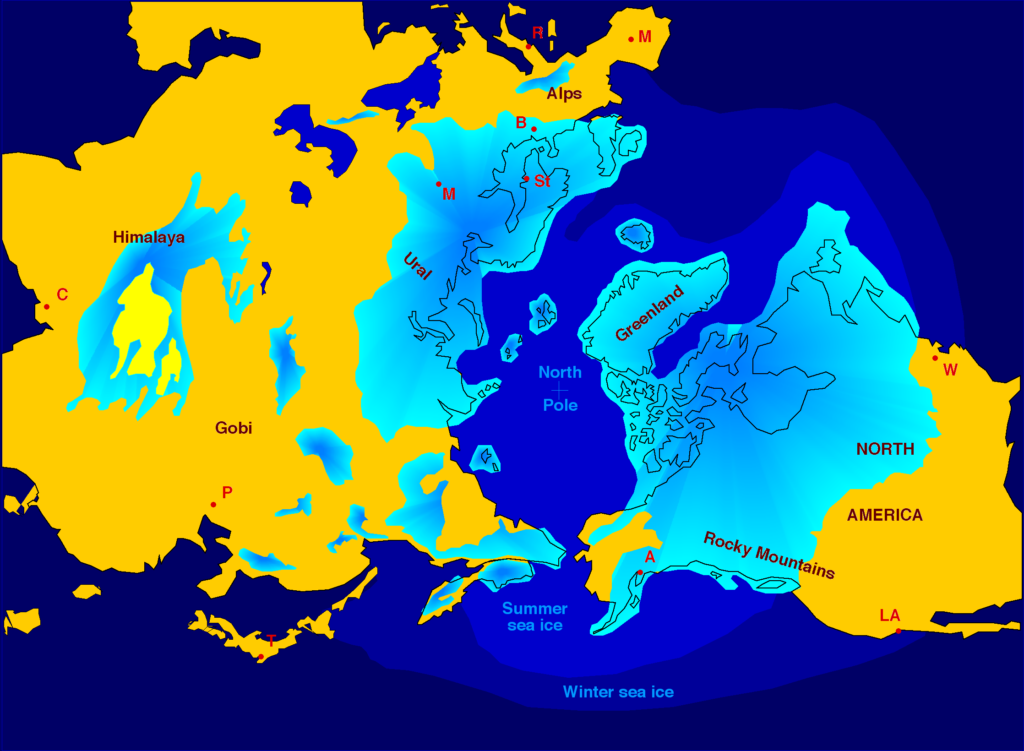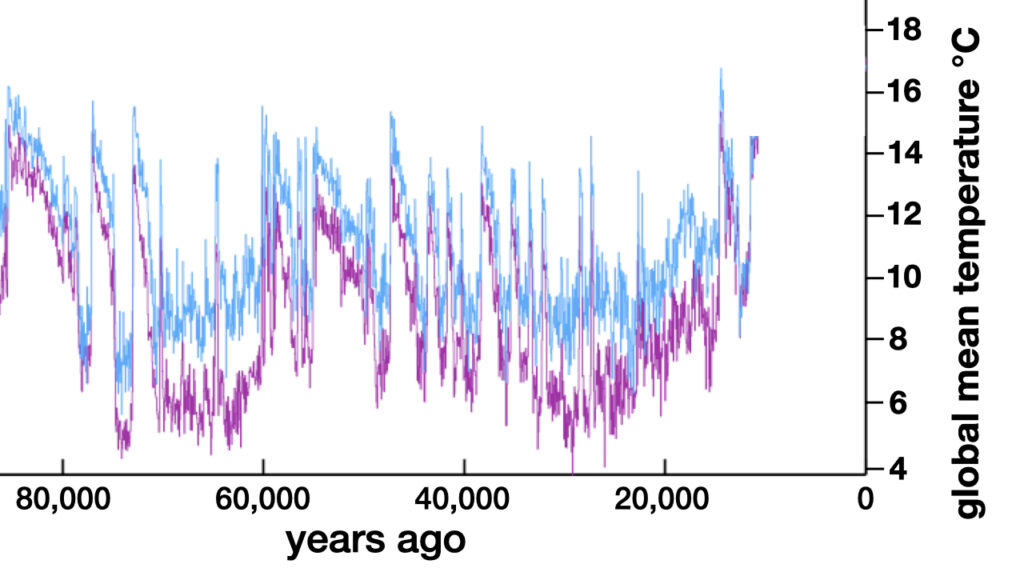Keeping Adam and Eve Warm during an Ice Age
I am frequently asked this question: Given that Adam and Eve were not wearing clothing before they sinned, how were they able to stay warm enough to exist and thrive? The question becomes all the more perplexing when people understand that the context of Genesis 2 implies that Adam and Eve were living during an ice age.
In my book Navigating Genesis I explain why the creation of Adam and Eve must have occurred during an ice age.1 Briefly, Genesis 2 states that before Adam and Eve sinned against God they were naked in the Garden of Eden. Genesis 2 also states that four known rivers, the Euphrates and Tigris, which are still flowing, and the Pishon and Gihon, which dried up toward the end of the last age, came close together in the Garden of Eden. The only geographical location where these four rivers could be in close proximity to one another is in the southeastern part of the Persian Gulf. Today, this location is more than 200 feet below sea level. However, during most of the last ice age it was above sea level. Therefore, I conclude that Adam and Eve existed during an ice age, most likely the previous one, and until they sinned, they existed without the benefit of clothing. How?
Human Anatomy
The human anatomy is wonderfully designed for warm climate conditions but poorly designed for cold ones. Humans are bipedal, tall, and slim. Hence, exposure of our bodies to the Sun’s heat is minimized. Our extremely high skin-surface-to-body-weight ratio and the minimal amount of hair on our bodies help keep us cool under high-temperature conditions. Furthermore, we are endowed with an amazingly productive perspiration system. Early humans used these unique advantages to hunt for prey during the hottest hours of the day when other large predators were forced to retreat and sleep in well-shaded refuges and prey could be chased to the point of heat exhaustion.
Those anatomical advantages for warm climate conditions become major detriments in cold conditions. Our bodies are not designed to retain body heat. When it is cold, we succumb to hypothermia within minutes. However, due to their unique brains and manual dexterity, humans were able to manufacture a broad diversity of clothing products. We can clothe our bodies with just-right garments to match the climate conditions we face.
Neanderthal anatomy is poorly designed for warm but wonderfully designed for cool temperature conditions. Nevertheless, some early humans inhabited regions that were, on average, 15°C colder than the coldest conditions that Neanderthals were able to withstand. The difference was that these early humans wore well-fitted insulating clothing that covered nearly all their bodies whereas, at best, Neanderthals may have draped animal hides over parts of their bodies as capes.
Adam and Eve in Eden
Genesis 2:25, in reference to Adam and Eve before they sinned, states “Adam and his wife were both naked.” They were naked when Earth was in the midst of an ice age. How did they avoid hypothermia?
During the last ice age, sheets of ice more than a thousand feet thick covered as much as 23% of Earth’s landmasses. Figure 1 shows the maximum extent of such ice during the last ice age. The location of the Garden of Eden is approximately 2,750 kilometers (1,700 miles) south of the nearest ice sheet. Hence, the temperature difference between the Garden of Eden and the south tip of the Eurasian ice sheet would be roughly equivalent to the temperature difference between Edmonton, Alberta, and Hermosillo, Mexico.

Credit: US Geological Survey
The previous ice age persisted from about 120,000 to 14,000 years ago. During that time period, the global mean temperature fluctuated by ±6°C (±11°F). Figure 2 shows the temperature swings throughout the last ice age. No one knows exactly when—during the last ice age, or possibly the one previous to it—God created Adam and Eve. However, it certainly is conceivable that God created Adam and Eve during one of the brief warm episodes of the ice age.

For comparison, the present global mean temperature is about 17°C.
Data credit: NGRIP (blue); GRIP (purple); Diagram credit: Hugh Ross
Earth’s Hot Spot
When we think about the warmest places on Earth, our minds go to the tropics. Southern India, Borneo, New Guinea, the Congo, and South Sudan are famous for their oppressive heat. As for marine regions, the South China Sea, the Coral Sea, and the Java Sea are equally famous for their heat. The world’s hottest sea, however, is not in the tropics. It is north of the tropics. The Persian Gulf holds the record as Earth’s hottest sea.2 The southern part of the Persian Gulf is much warmer than the mid to northern parts of the Gulf.3
During an ice age, nearly all of what is now the Persian Gulf became the Persian Oasis—land with four large rivers flowing through it and plentiful springs fed by the large underground aquifer in the region. Earth’s presently hottest sea likely became Earth’s hottest land region. Adam and Eve would have been quite comfortable in Eden without any clothing. Genesis 3:7 declares that after Adam and Eve had sinned they sewed a few fig leaves together to cover up their nakedness, not out of a need for warmth, but to cover up their shame.
The heat of the Persian Gulf/Persian Oasis region provides evidence that God created Adam and Eve during an ice age. If God had created them during an interglacial period, the Garden of Eden location would have been too warm during the summer months for Adam and Eve and their offspring to thrive. An ice age date for the creation of Adam and Eve is consistent with the best scientific dates for the origin of modern humans.4
Endnotes
- Hugh Ross, Navigating Genesis: A Scientist’s Guide to Genesis 1–11 (Covina, CA: RTB Press, 2014), 96–100.
- B. C. C. Hume et al., “Symbiodinium thermophilum sp. nov., a Thermotolerant Symbiotic Alga Prevalent in Corals of the World’s Hottest Sea, the Persian/Arabian Gulf,” Scientific Reports 5 (February 27, 2015): id. 8562, doi:10.1038/srep08562.
- B. Hume et al., “Corals from the Persian/Arabian Gulf as Models for Thermotolerant Reef-Builders: Prevalence of Clade C3 Symbiodinium, Host Fluorescence and Ex Situ Temperature Tolerance,” Marine Pollution Bulletin 72, no. 2 (July 30, 2013): 313–22, doi:10.1016/j.marpolbul.2012.11.032; Charles Sheppard et al., “The Gulf: A Young Sea in Decline,” Marine Pollution Bulletin 60, no. 1 (January 2010): 13–38, doi:10.1016/j.marpolbul.2009.10.017.
- Hugh Ross, “Errors in Human Origins Dates,” Today’s New Reason to Believe (blog), Reasons to Believe, June 29, 2020.






